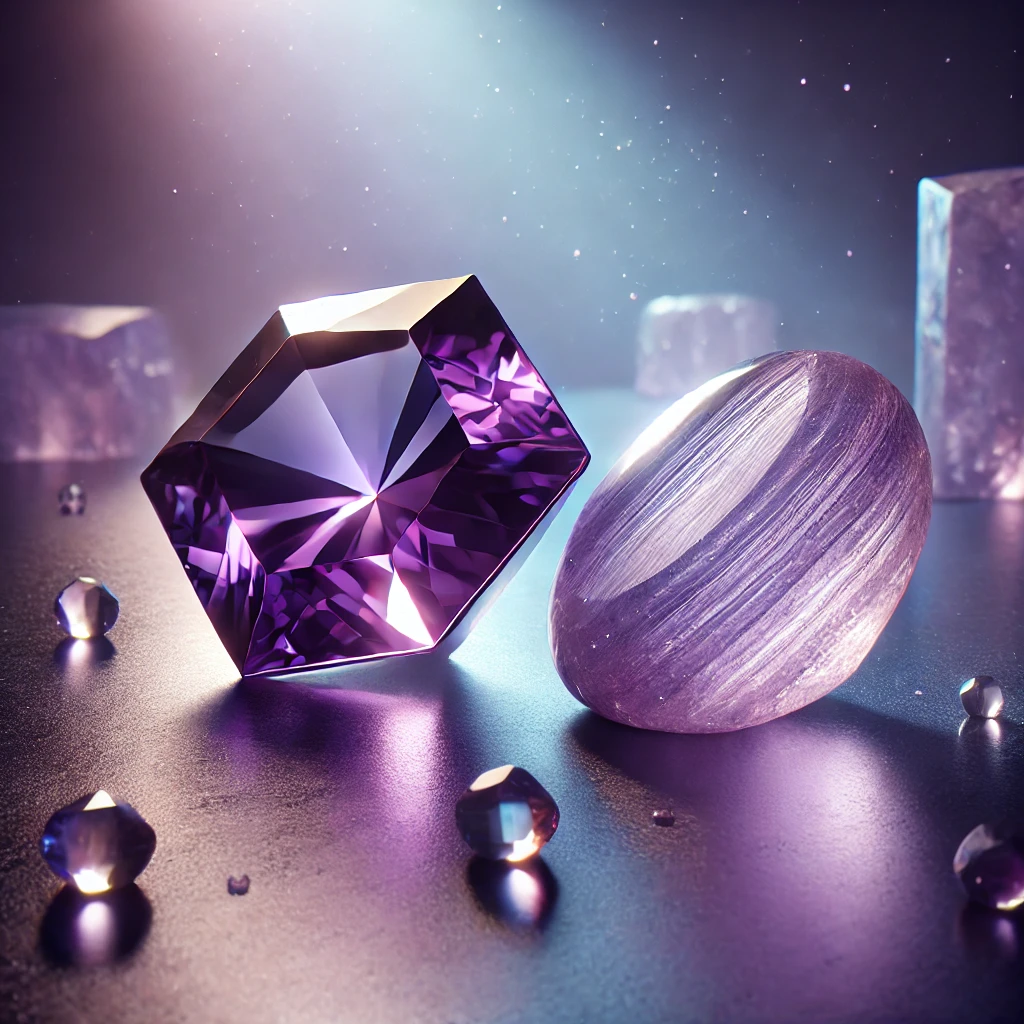February Birthstones: Amethyst Meaning & Healing Power
People born in February are associated with two significant birthstones:
- Precious Gem: Amethyst
- Common Gem: Lepidolite
Both gemstones are known for their calming, spiritual, and transformative properties, offering clarity, balance, and protection to those who wear them.
1. Amethyst – The Precious Birthstone of February
1.1 Overview and Meaning
Amethyst is the traditional and precious birthstone for February, symbolizing spiritual wisdom, tranquility, and protection. This deep purple quartz has been cherished for centuries as a stone of intuition, higher consciousness, and inner peace.
1.2 History and Mythology
- The name Amethyst comes from the Greek word amethystos, meaning “not intoxicated”, as it was believed to prevent drunkenness.
- Ancient Egyptians used Amethyst for protection and healing in jewelry and amulets.
- In Greek mythology, the stone was associated with Dionysus, the god of wine, and believed to counteract the effects of alcohol.
- Amethyst was a favored gemstone among royalty and clergy, symbolizing purity, wisdom, and divine connection.
1.3 Healing and Metaphysical Properties
✅ Spiritual Awareness – Enhances intuition, meditation, and psychic abilities.
✅ Calming Energy – Reduces stress, anxiety, and emotional turmoil.
✅ Protection & Cleansing – Creates a protective spiritual shield against negativity.
✅ Chakra Connection – Linked to the Third Eye and Crown Chakras, promoting higher consciousness and enlightenment.
1.4 Variations and Colors
Although Amethyst is typically deep purple, it can range from light lavender (Rose de France Amethyst) to intense royal purple.
1.5 Uses and Jewelry
- Amethyst is a popular gemstone for rings, pendants, earrings, and bracelets due to its vibrant beauty.
- It is often used in meditation tools, crystal grids, and spiritual altars.
- It is gifted for 6th and 17th wedding anniversaries as a symbol of enduring love and wisdom.
2. Lepidolite – The Common Birthstone of February
2.1 Overview and Meaning
Lepidolite is the common or alternative February birthstone, known for its calming, balancing, and transformative properties. This lilac to purple-hued mica mineral is rich in lithium, making it an excellent stone for emotional healing, anxiety relief, and deep relaxation.
2.2 History and Mythology
- The name Lepidolite comes from the Greek word lepidos, meaning “scale”, referring to its shimmery, layered texture.
- It has been used for centuries as a stone of transition, helping people move through life changes with grace.
- In ancient times, it was believed to be a stone of inner peace, often kept in temples for spiritual practices.
- Healers have long used Lepidolite for calming the nervous system and easing stress-related ailments.
2.3 Healing and Metaphysical Properties
✅ Emotional Healing – Helps release anxiety, depression, and emotional blockages.
✅ Tranquility & Sleep Aid – Calms the mind and nervous system, making it beneficial for insomnia and deep relaxation.
✅ Transformation & Change – Supports smooth life transitions and personal growth.
✅ Chakra Connection – Primarily linked to the Heart, Third Eye, and Crown Chakras, assisting in emotional balance and spiritual awakening.
2.4 Uses and Jewelry
- Lepidolite is often used in meditation, energy healing, and crystal therapy.
- Due to its soft and flaky composition, it is commonly carved into palm stones, beads, and worry stones rather than faceted jewelry.
- It is especially beneficial for those who experience high levels of stress, emotional instability, or spiritual transformation.
3. Comparing Amethyst and Lepidolite
| Feature | Amethyst (Precious Birthstone) | Lepidolite (Common Birthstone) |
|---|---|---|
| Color | Deep purple, lavender, violet | Lilac, pinkish-purple, shimmery mica |
| Symbolism | Spiritual growth, clarity, protection | Emotional balance, tranquility, transformation |
| Chakra Association | Third Eye & Crown Chakras | Heart, Third Eye & Crown Chakras |
| Energy Type | High-vibrational, divine connection | Calming, stress relief, transformation |
| Metaphysical Use | Meditation, psychic development, energy cleansing | Anxiety relief, emotional healing, deep relaxation |
| Common Uses | Jewelry, healing tools, spiritual altars | Palm stones, worry stones, meditation tools |
4. Care and Maintenance of February Birthstones
4.1 How to Cleanse and Charge Amethyst and Lepidolite
- Water Cleansing: Amethyst can be rinsed with lukewarm water, but Lepidolite is fragile and should not be exposed to water.
- Sunlight Charging: Amethyst fades in direct sunlight, so charge it with moonlight instead.
- Moonlight Charging: Both Amethyst and Lepidolite benefit from full moon energy for deep cleansing.
- Smudging: Use sage, palo santo, or incense smoke to cleanse energetic impurities.
- Selenite or Quartz Charging: Placing these stones on a selenite plate or near clear quartz enhances their energy.
4.2 Storing and Handling
- Lepidolite is soft and delicate, so it should be handled carefully and stored separately from harder stones.
- Amethyst is more durable but should still be kept away from harsh chemicals and direct sunlight to preserve its vibrant color.
5. Conclusion
February’s birthstones, Amethyst and Lepidolite, are powerful stones for spiritual growth, emotional balance, and inner peace. Whether choosing the majestic, protective Amethyst or the soothing, transformative Lepidolite, both gemstones offer unique energies that support clarity, relaxation, and personal evolution.

